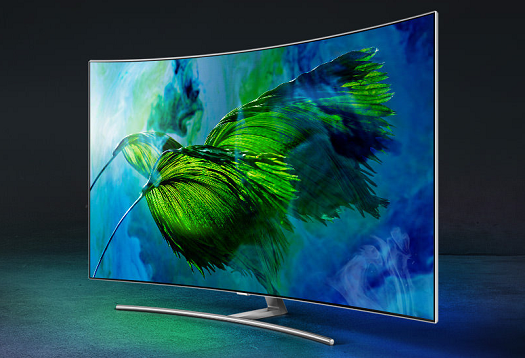Quantum dot-equipped LCD television displays are set to capture the majority of the wide colour gamut television market, consultancy firm Yole Développement has reported. This is due to the increasing performance and decreasing cost of quantum dots, along with the current lack of existing manufacturing capabilities for competing OLED displays.

Quantum dot-enhanced displays enable dramatic improvement in colour gamut, brightness and contrast without increasing power consumption (Credit: Samsung)
Quantum dot colour conversion films equipped in the backlights of LCD televisions enable dramatic improvement of the displays’ colour gamut, brightness and contrast without increasing their power consumption. These factors, along with the ease with which quantum dots can be deployed in displays of all sizes, will enable the LCD industry to boost the performance of its products without any major capital investment or having to change its manufacturing processes.
With the rapidly improving performance and decreasing cost of quantum dots, enhanced LCD displays will be able to take advantage of an upcoming window of limited production for organic LED (OLED) displays – the other main contender capable of delivering wide colour gamut and high dynamic range – and become widely adopted in mid-high range television displays, thus capturing the majority of the wide colour gamut TV market.
OLEDs require the building of entire new production facilities to incorporate into televisions, creating high cost and technology barriers that make it challenging for companies to enter OLED television panel production.
As a result, LG Display is currently the only manufacturer of OLED television panels, according to Yole, and although the firm is due to build two new OLED television manufacturing lines in Korea and China, these are only set to start production in late 2019. Unless OLED printing technologies progress fast enough to become cost efficient, this lack of production capability will result in the capacity of OLED television adoption being limited to less than 12 million units per year until 2022.
While the presence of quantum dot-enhanced LCD displays will increase, the technology still lags in terms of response times, black levels, viewing angles and pixel-level dimming – strong selling points for OLED displays. However, LCD display efficiency, colour gamut and viewing angles could be improved further if their colour filters were substituted by quantum dots - although this would require some process changes in LCD manufacturing. In the longer term, electroluminescent quantum dots could prove disruptive to both OLED and quantum dot-enhanced LCD displays by enabling OLED-like characteristics and performance with improved brightness and stability, Yole has reported.
Currently, Samsung is generating the most demand for quantum dots; the company acquired quantum dot manufacturer QD-Vision’s intellectual property in 2016, according to Yole. As a result of this acquisition, Nanosys and Hansol are now reportedly the only manufacturers supplying high volumes of quantum dots in 2017; however, this could change rapidly as more TV makers adopt the emerging technology.

